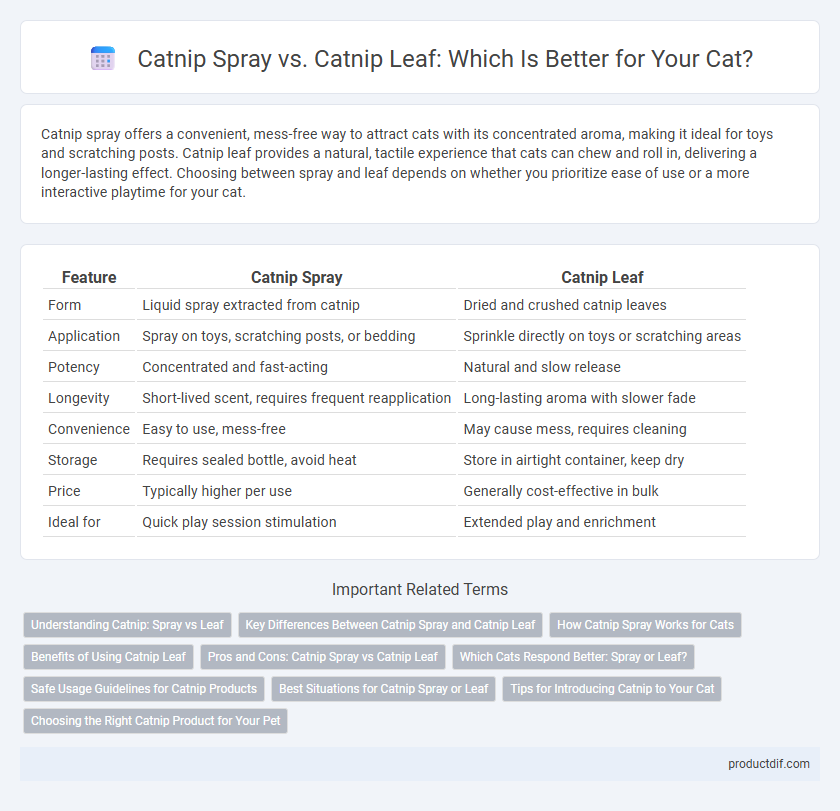Catnip spray offers a convenient, mess-free way to attract cats with its concentrated aroma, making it ideal for toys and scratching posts. Catnip leaf provides a natural, tactile experience that cats can chew and roll in, delivering a longer-lasting effect. Choosing between spray and leaf depends on whether you prioritize ease of use or a more interactive playtime for your cat.
Table of Comparison
| Feature | Catnip Spray | Catnip Leaf |
|---|---|---|
| Form | Liquid spray extracted from catnip | Dried and crushed catnip leaves |
| Application | Spray on toys, scratching posts, or bedding | Sprinkle directly on toys or scratching areas |
| Potency | Concentrated and fast-acting | Natural and slow release |
| Longevity | Short-lived scent, requires frequent reapplication | Long-lasting aroma with slower fade |
| Convenience | Easy to use, mess-free | May cause mess, requires cleaning |
| Storage | Requires sealed bottle, avoid heat | Store in airtight container, keep dry |
| Price | Typically higher per use | Generally cost-effective in bulk |
| Ideal for | Quick play session stimulation | Extended play and enrichment |
Understanding Catnip: Spray vs Leaf
Catnip spray offers a concentrated and mess-free option for stimulating cats, providing immediate effects through the application of catnip oil extract. In contrast, catnip leaf delivers a natural form of catnip with its fibrous texture that encourages chewing and rolling behavior in cats. Understanding the differences in potency, usability, and interaction style helps pet owners choose between catnip spray and catnip leaf for their feline companions.
Key Differences Between Catnip Spray and Catnip Leaf
Catnip spray offers a concentrated, easy-to-apply solution that delivers immediate aromatic stimulation for cats, while catnip leaves provide a natural, tactile experience encouraging chewing and rolling behavior. Catnip spray has a longer shelf life and less mess compared to dried catnip leaves, which can crumble and disperse. The potency of catnip spray is consistent, whereas the strength of catnip leaves can vary depending on harvest and storage conditions.
How Catnip Spray Works for Cats
Catnip spray releases concentrated nepetalactone, the active compound that triggers a cat's sensory receptors, creating a stimulating and euphoric reaction. This method provides an immediate and mess-free way to attract cats to toys, beds, or scratching posts, enhancing play and relaxation. Unlike dried catnip leaves, the spray's potency is consistent and long-lasting, making it an effective tool for engaging felines.
Benefits of Using Catnip Leaf
Catnip leaf offers a natural, long-lasting scent that effectively attracts cats and encourages playful behavior, promoting mental stimulation and reducing stress. The concentrated essential oils in fresh catnip leaf provide a stronger, more consistent aroma compared to synthetic sprays. Using catnip leaf also allows for versatility in application, such as sprinkling on toys or scratching posts to enhance enrichment.
Pros and Cons: Catnip Spray vs Catnip Leaf
Catnip spray offers convenience and less mess while providing immediate aromatic stimulation, making it ideal for use on toys and scratching posts; however, its effects may be less potent and shorter-lived compared to catnip leaf. Catnip leaf delivers a more natural and intense experience that encourages prolonged play and enrichment but can be messy and requires storage care to maintain freshness. Choosing between catnip spray and leaf depends on the cat's preferences and owner's convenience, balancing potency with ease of use.
Which Cats Respond Better: Spray or Leaf?
Catnip spray tends to attract cats that prefer strong, immediate scents, offering quick stimulation through concentrated nepetalactone. Catnip leaf appeals more to cats that enjoy a natural, tactile experience, allowing them to chew or roll in the dried leaves for gradual exposure. Response varies with individual cats' sensitivity and preference, with younger cats often reacting more to spray and mature cats favoring the leaf.
Safe Usage Guidelines for Catnip Products
Catnip spray and catnip leaf both offer safe enjoyment for cats when used according to product guidelines, with sprays providing controlled application and leaves allowing for natural interaction. Limit usage to short play sessions, typically 10-15 minutes, to prevent overstimulation or adverse reactions in cats. Always monitor your cat's behavior during use and consult with a veterinarian if any signs of distress or allergies occur.
Best Situations for Catnip Spray or Leaf
Catnip spray is ideal for quickly refreshing toys, scratching posts, or bedding to instantly attract cats during playtime or training sessions. Catnip leaf works best for longer-lasting enrichment, allowing cats to chew or roll directly on the plant material, promoting natural behaviors and mental stimulation. Use spray for convenience and immediate effect, while leaf is preferred for sustained engagement and interactive experiences.
Tips for Introducing Catnip to Your Cat
Start by offering a small amount of catnip spray or a pinch of dried catnip leaf to observe your cat's reaction. Use catnip spray on toys or scratching posts to create controlled exposure, while loose catnip leaves can be placed in a designated play area for exploratory sniffing. Gradually increase the catnip amount based on your cat's sensitivity to avoid overstimulation and encourage positive engagement.
Choosing the Right Catnip Product for Your Pet
Selecting the right catnip product depends on your cat's preferences and intended use; catnip spray offers a mess-free, quick application ideal for toys and scratching posts, while catnip leaf provides a more natural, aromatic experience perfect for direct play or consumption. Catnip spray is concentrated, making it convenient for controlled doses, whereas catnip leaf contains essential oils that encourage prolonged interaction and chewing. Understanding your cat's behavior and sensitivity to nepetalactone, the active compound, ensures you choose a product that maximizes stimulation and enjoyment.
Catnip Spray vs Catnip Leaf Infographic

 productdif.com
productdif.com